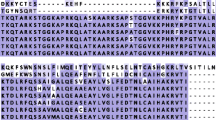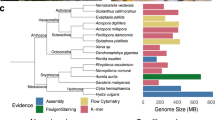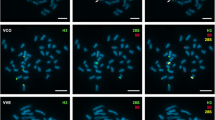Abstract
We report the nucleotide sequence of the core histone gene cluster from the Cnidarian Acropora formosa. This is the first histone gene cluster to be sequenced from a diploblastic organism and the predicted amino acid sequences most resemble those of sea urchin equivalents. Each of the Cnidarian histone genes has two conserved regions 3′ of the coding sequences and these closely resemble those of the metazoan a-class histone genes. In A. formosa the core histone genes are arranged as opposed (H3/H4 and H2A/H2B) pairs, a pattern common to the nondeuterostome metazoa, and tandem repetition is the predominant pattern of organization in the Cnidarian. With the recent identification of several classes of homeobox genes in Cnidarians these features clearly align the Cnidaria with triploblastic metazoans, supporting a monophyletic origin of the metazoa.
Similar content being viewed by others
References
Anderson DT (1982) Origins and relationships among the animal phyla. Proc Linn Soc NSW 106: 151–166
Aragay AM, Fernandez-Busquets X, Daban J (1991) Different mechanisms for in vitro formation of nucleosome core particles. Biochem 30: 5022–5032
Bergstrom J (1991) The early evolution of metazoa and the significance of problematic taxa. (Proc Int Symp Univ Camerino 27–31 March 1989). Cambridge University Press, Cambridge, 23 pp
Boseman-Roberts S, Emmons SW, Childs G (1989) Nucleotide sequences of Caenorhabditis elegans core histone genes. Genes for different histone classes share common flanking sequence elements. J Mol Biol 206: 567–577
Boseman-Roberts S, Sanicola M, Emmons SW, Childs G (1987) Molecular characterization of the histone gene family on Caenorhabditis elegans. J Mol Biol 196: 27–38
Britten RJ, Davidson EH (1971) Repetitive and non repetitive DNA sequences and a speculation on the origins of evolutionary novelty. Quart Rev Biol 46: 111–133
Brunk CF, Kahn RW, Sadler LA (1990) Phylogenetic relationships among Tetrahymena species determined using the polymerase chain reaction. J Mol Evol 30: 290–297
Cavalier-Smith T (1989) Archaebacteria and archezoa. Nature 339: 100–101
Christen R, Ratto A, Baroin A, Perasso R, Grell KG, Adoutte A (1991) An analysis of the origin of metazoans, using comparisons of partial sequences of the 28S RNA, reveals an early emergence of triploblasts. EMBO J 10: 499–503
Cool D, Banfield D, Honda BM, Smith MJ (1988) Histone genes in three sea star species: cluster arrangement, transcriptional polarity, and analyses of the flanking regions of H3 and H4 genes. J Mol Evol 27: 36–44
Davis LG, Dibner MD, Battey JF (1986) Basic methods in molecular biology. Elsevier, New York, NY
Felsenstein J (1988) Phylogenies from molecular sequences: inference and reliability. Ann Rev Genet 22: 521–565
Field KG, Olsen GJ, Lane DJ, Giovannoni SJ, Ghiselin MT, Raff EC, Pace NR, Raff RA (1988) Molecular phylogeny of the animal kingdom. Science 239: 748–753
Ghiselin MT (1989) Summary of our present knowledge of metazoan phylogeny. In: Fernholm B, Bremer K, Jornvall H (eds) The heirachy of life. Elsevier Science, Amsterdam, pp 263–272
Harrison PL, Wallace CC (1990) Reproduction, dispersal and recruitment of scleractinian corals. In: Dubinsky, Z (ed) Coral reef ecosystems. Chapter 7, Elsevier, Amsterdam
Harvey RP, Robins AJ, Wells JRE (1982) Independently evolving chicken histone H2B genes: identification of a ubiquitous H213-specific 5′ element. Nucleic Acids Res 10: 7851–7863
Hattori M, Sakaki Y (1986) Dideoxy sequencing method using denatured plasmid templates. Anal Biochem 152: 232–238
Henikoff S (1987) Unidirectional digestion with exonuclease III in DNA sequence analysis. Methods Enzymol 155: 156–165
Hereford LM, Fahmer K, Woolford J Jr, Rosbash M, Kaback DB (1979) Isolation of yeast histone genes H2A and H2B. Cell 18: 1261–1271
Howell AM, Cool D, Hewitt J, Ydenberg B, Smith MJ, Honda BM (1987) Organization and unusual expression of histone genes in the sea star Pisaster ochraceus. J Mol Evol 25: 29–36
Hyman LH (1940) The invertebrates: Protozoa through Ctenopora. McGraw-Hill, New York, NY
John B, Miklos GLG (1988) The eukaryote genome in development and evolution. Allen and Unwin, London
Lake JA (1990) Origin of the Metazoa. Proc Natl Acad Sci USA 87: 763–766
Lake JA (1991) Tracing origins with molecular sequences: metazoan and eukaryotic beginnings. TIBS 16: 46–50
Lifton RP, Goldberg ML, Karp RW, Hogness DS (1977) The organization of the histone genes in Drosophila melanogaster: functional and evolutionary implications. Cold Spring Harbor, Symp Quant Biol 42: 1047–1051
Maniatis T, Fritsch EF, Sambrook J (1982) Molecular cloning: a laboratory manual. Cold Spring Harbor Press, New York, NY
Miles A, Miller DJ (1992) Genomes of diploblastic organisms contain homeoboxes: sequence of eveC, an even-skipped homolog from the cnidarian Acropora formosa. Proc R Soc Lond (Series B) 248: 159–161
McMillan J, Yellowlees D, Heyward A, Harrison P, Miller DJ (1988) Preparation of high molecular weight DNA from hermatypic corals and its use for DNA hybridization and cloning. Mar Biol 98: 271–276
Miller DJ, McMillan J, Miles A, ten Lohuis M, Mahony T (1990) Nucleotide sequence of the histone H3-encoding gene from the scleractinian coral Acropora formosa (Cnidaria: Scleractinia). Gene 93: 319–320
Muller K, Lindauer A, Bruderlein M, Schmitt R (1990) Organisation and transcription of Volvox histone-encoding genes: similarities between algal and animal genes. Gene 93: 167–175
Muller K, Schmitt R (1988) Histone genes of Volvox carteri: DNA sequence and organisation of two H3-H4 gene loci. Nucleic Acids Res 16: 4121–4137
Sanger F, Nicklen S, Coulson AR (1977) DNA sequencing with chain-terminating inhibitors. Proc Natl Acad Sci USA 74: 5463–5467
Schaffner W, Kunz G, Daetwyler H, Telford J, Smith HO, Birnsteil ML (1978) Genes and spacers of cloned sea urchin histone DNA analyzed by sequencing. Cell 14: 655–671
Schaufele F, Gilmartin GM, Bannwarth W, Birnstiel ML (1986) Compensatory mutations suggest that base-pairing with a small nuclear RNA is required to form the 3′ end of H3 messenger RNA. Nature 323: 777–781
Schummer M, Scheurlen I, Schaller C, Galliot B (1992) HOM/HOX homeobox genes are present in hydra (Chlorohydra viridissima) and are differentially expressed during regeneration. EMBO J 11: 1815–1823
Schumperli D (1988) Multilevel regulation of replicationdependent histone genes. Trends Genet 4: 187–191
Sellos D, Krawetz SA, Dixon GH (1990) Organization and complete nucleotide sequence of the core-histone gene cluster of the annelid Platynereis dumerilii. Eur J Biochem 190: 21–29
Smith MM, Andresson OS (1983) The sequences of yeast H3 and H4 histone genes from two non-allelic gene sets encode identical H3 and H4 proteins. J Mol Biol 169: 663–690
Sturm RA, Dalton S, Wells JRE (1988) Conservation of histone H2A/H2B intergene regions: a role for the H2B specific element in divergent transcription. Nucleic Acids Res 16: 8571–18586
Tabor S, Richardson, CC (1987) DNA sequence analysis with a modified bacteriophage T7 DNA polymerase. Proc Natl Acad Sci USA 84: 4767–4771
Wells D, Bains W, Kedes L (1986) Codon usage in histone gene families of higher eukaryotes reflects functional rather than phylogenetic relationships. J Mol Evol 23: 224–241
Wells D, Brown D (1991) Histone and histone gene compilation and alignment update. Nucleic Acids Res 19 (Suppl): 2173–2188
Woudt LP, Pastink A, Kempers-Veenstra AE, Jansen AEM, Mager WH, Planta RJ (1983) The genes coding for histone H3 and H4 in Neurospora crassa are unique and contain intervening sequences. Nucleic Acids Res 11: 5347–5360
Author information
Authors and Affiliations
Rights and permissions
About this article
Cite this article
Miller, D., Harrison, P., Mahony, T. et al. Nucleotide sequence of the histone gene cluster in the coral acropora formosa (cnidaria; scleractinia): Features of histone gene structure and organization are common to diploblastic and triploblastic metazoans. J Mol Evol 37, 245–253 (1993). https://doi.org/10.1007/BF00175501
Received:
Revised:
Issue Date:
DOI: https://doi.org/10.1007/BF00175501




